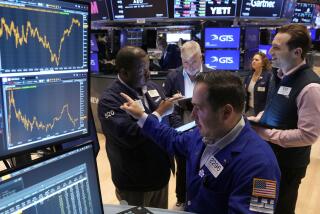Q&A; : How EC Monetary Crisis Affects U.S. Investors
The latest crisis that has enveloped European currency markets has far greater potential ramifications than may be obvious. This is about much more than how many French francs it takes to buy a German mark.
Here are some questions and answers about the possible short-term and long-term impact of the currency crisis on investors in the stock and bond markets here and abroad, and on the U.S. and global economies:
Q: What is likely to happen next in Europe?
A: It appears that France and other European countries now are free to begin cutting their interest rates sharply to spur growth, breaking their ties to Germany’s high rates even though that will mean deep currency devaluations. By agreeing on Sunday to allow wide fluctuations in their formerly closely linked currencies, Europe’s major countries can adopt more independent economic policies.
European stock markets had anticipated as much last week: In Paris, the CAC-40 stock index rocketed 90.85 points for the week, or 4.5%, to close at 2,085.88 on Friday.
Buyers were betting that lower interest rates will revive the French economy and thus corporate profits--mimicking what has occurred in the United States over the past two years.
Indeed, European stock markets, at least outside Germany, would likely be big beneficiaries over the next 12 months of a de facto breakup of the ERM, or exchange rate mechanism, which has linked interest rates in Europe for the past 14 years.
And if Germany itself relents and cuts interest rates faster than expected, the result should be the same: Higher European stock prices, anticipating renewed economic growth.
Q: How should U.S. investors play this?
A: Betting on a turnaround in the European economy can be as simple as owning a well-diversified international stock mutual fund. And in fact, Americans’ purchases of international stock funds have been extraordinarily strong in recent months, which means that many investors are already positioned to benefit if Europe turns.
But note that most European markets were rallying even before the ERM crisis, which suggests that the markets have at least partially discounted an economic recovery. The Italian stock market, for example, is up 36% in local currency so far this year, according to Morgan Stanley Capital International. Sweden’s market is up 35%, and Spain’s has surged 32%.
Nonetheless, many experts believe that European markets have more upside potential in an environment of lower interest rates and renewed growth--just as the U.S. stock market has defied naysayers by continuing to climb for 2 1/2 years, as interest rates have dropped.
“I would say investors are (relatively) better off in Europe,” says Steven Nagourney, global market strategist for brokerage Lehman Bros. in New York.
Q: What are the risks in buying European stocks now?
A: First, there is the strong possibility that lower interest rates will fail to work much economic magic in Europe in the near term. That could cause stocks to pull back. Still, further economic weakness would probably just force deeper interest rate cuts, ultimately positive for stocks, experts note. (Remember the U.S. experience.)
Second, it’s important to remember that weakness in European currencies generally translates into a stronger dollar, as currency traders seek a safe haven from money that is losing value. Already this year, the dollar has gained by default from Europe’s troubles: The dollar is up 8.2% against the French franc and 26.6% against the Spanish peseta.
As the dollar rises, it automatically reduces the value of U.S. investors’ overseas holdings (because when translated from native currencies to dollars, foreign investments buy fewer dollars). For example, while the Spanish stock market has surged 32% this year, a U.S. investor owning those Spanish stocks has a gain of just 4%.
But overall, U.S. investors still have earned more money overseas this year than at home. The average international stock fund is up 17% in dollar terms since Jan. 1, versus a 3% rise for the average U.S. growth stock fund, according to fund-tracker Lipper Analytical Services.
Q: What about betting on European bonds?
A: That is a somewhat dicier situation, because the problem in Europe has been high short-term interest rates; long-term yields, such as those on bonds, have already come down a lot, and in many countries are actually below short-term rates.
In France, for example, 10-year government bonds yield 6.67%, while three-month money market yields are about 7.25%. (In the United States, in contrast, 10-year Treasury yields are at 5.81% versus 3.09% on three-month paper.)
That suggests there is less potential for a huge drop in European long-term yields, which may mean limited capital gains potential in foreign bond funds. And if the dollar rises further, it could quickly snuff out any foreign bond appreciation.
Even so, foreign bond mutual funds as a group have survived the dollar’s rise fairly well this year. The average total return on foreign bond funds was 8.57% in the first half, compared with a 6.59% return for the typical U.S. Treasury bond fund, Lipper says.
Some Wall Streeters argue that because European bonds still pay sharply higher yields than U.S. bonds, foreign bond funds remain the smart way to bet if you believe that interest rates worldwide will continue to fall.
Q: Can American investors make direct bets on European currencies?
A: Yes. Individuals can trade options or futures contracts on major currencies, betting either that they will rise or plunge in value versus the dollar. The nature of these contracts is that you control a large amount of currency for relatively little money down (say, a few thousand dollars).
That means you can make a substantial profit on small currency shifts. But it also means you can lose vast sums if you bet wrong. Obviously, these are instruments only for high rollers. They require a lot of knowledge, and constant monitoring.
A simpler way to play the currency disarray is to own gold, some analysts say. Gold surged over $400 last week as currency traders sought a safe haven.
Many Wall Streeters believe the metal is poised for further gains, because the new European currency system announced Sunday may do little to stop rampant speculation in the currencies. If volatility increases, more currency traders may be forced to hedge their bets with gold.
Q: What’s the potential fallout for U.S. stocks and bonds?
A: If European interest rates slide and the Continent revives, that should ultimately mean greater demand for U.S. exports in Europe and better business for U.S. multinational companies that manufacture and sell there. So an ERM breakup would be a plus for U.S. stocks in that sense.
Though the Dow Jones industrial average fell 27.95 points to 3,539.47 on Friday as the ERM crisis ballooned, the U.S. market won’t be able to ignore the positives for very long, argues Bill Dodge, investment strategist at Dean Witter Reynolds in New York. The prospect of lower European interest rates means “it’s Christmas in July (for the U.S. market), looking out the next 12 to 18 months,” he contends.
Likewise, falling European rates could have a depressant effect on U.S. interest rates: The lower rates go in Europe, more investors there may switch to U.S. bonds in search of better yields. Greater demand for U.S. bonds should translate into lower yields.
Note, too, that a rising dollar gives European investors added incentive to buy U.S. securities (stocks and bonds), because the dollar’s strength works in reverse for them, automatically boosting the value of investments they make here.
Q: This all sounds too good to be true.
A: And it may be, in the short run. The big unknown is whether the disarray in the ERM and general uncertainty about Europe’s future will cause business activity to contract further in the next few months. If that happens, European and U.S. stock markets could suffer sharp hits.
“It’s not in the interest of the United States or anyone else to see Europe flounder for very long (with the ERM crisis),” warns Jean-Marie Eveillard, manager of the SoGen International stock fund in New York.
For the same reason, if the ERM breakup means the dream of a United Europe is fading, that could ultimately be bad for many U.S. companies. In theory, anyway, a united Europe would have been an easier mega-market for U.S. companies to sell to and import from.
There also is another longer-term worry: that the desperate pressure for lower interest rates in Europe, as in the United States, is another sign that governments worldwide are willing to risk higher inflation to spur global growth.
The Germans, after all, have been cutting rates--but they have argued that it must be done slowly to avoid setting the stage for rapid growth and rapid inflation later on.
“If the result of all this is that central banks lose their ability to act independently (to restrain inflation), it’s not a good thing,” argues John Williams, economist at Bankers Trust in New York.
That may be an underlying reason for the rally in gold prices this year, some experts say: Rising gold suggests that higher inflation is on the horizon.
* RELATED COVERAGE OF MONETARY CRISIS: A1, A6
Dancing to Germany’s Tune
Most European nations have been forced to keep their interest rates up to match Germany’s, and the price has been high unemployment and recession. But if European rates now drop sharply, the result could be renewed economic growth--and higher stock prices.
Prime Estimated lending Jobless 1993 Nation rate rate GDP growth Spain 12.3% 16.4% -0.8% Italy 11.6% 10.6% -0.6% Sweden 10.5% 7.5% -1.9% Belgium 10.5% 9.4% -0.6% Germany 10.0% 8.2% -2.4% Netherlands 9.0% 5.0% -0.6% France 8.4% 11.5% -0.9% Britain 7.0% 10.4% +1.6% United States 6.0% 7.0% +2.7% Japan 4.0% 2.5% +1.0%
Source: The Economist magazine
More to Read
Inside the business of entertainment
The Wide Shot brings you news, analysis and insights on everything from streaming wars to production — and what it all means for the future.
You may occasionally receive promotional content from the Los Angeles Times.










